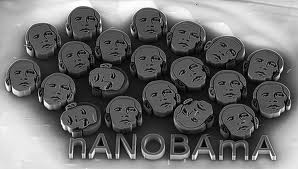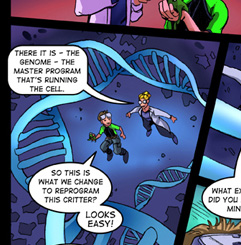Last year Hayley posted a really good article on this site entitled ‘What do we need to know about Nanotechnology?‘ She raised some important issues about the governance of such high technology including the facts that little research has been conducted into health implications, legal regulation is minimal and nobody really knows how much of this type of material is produced. It is however already everywhere, in cosmetics, car wax and sunscreen to name but a few.
She followed the post earlier this year with another, ‘Nanobots, the future in Nanotechnology‘. This is also an informative piece in which she describes how nanotech engineering is moving away from top down construction to a bottom up approach, and goes on to talk about the possibility of building autonomous and even self replicating robots on the nano-scale.
Last week I posted an article about synthetic biology, another branch of science that deals in the nano-scale. With synthetic biology one of the issues raised by Hayley, that of power source, is resolved, as the machines are in fact alive and get their power from the organism that they are implanted into. The two are very much related and entwined forms of science.
And all this leads me on to looking at regulation regarding these types of research and a recent publication entitled ‘A Research Strategy for Environmental, Health and Safety Aspects of Engineered Nanotechnologies’.
The document was prepared by the National Research Council and a pre publication copy is available from the National Academic Press for downloaded here.
This is a long and detailed document written with the help of a host of academics, and it raises some very important points about an industry that Barak Obama has placed at the forefront of his innovation policy. In this year’s budget Obama is asking for 123.5 million dollars to invest in nano-tech research, which if seen next to the relatively small investment of 34.8 million in 2005 signals the importance attached to this form of innovation.
But all of this investment is made in a technology that is as yet practically unregulated and severely lacking in health and safety legislation, with the problem being that exposure limits and contamination issues have yet to be formalized. All of this is despite the ever growing use of such particles in our everyday life.
The National Research Council document aims to develop such a research strategy starting from a conceptual framework for considering environmental, health and safety risks, through critical questions to understanding the problem, tools and approaches for identifying properties that may cause risk, resources needed and how to implement the strategy once it has been described.
The document is extremely thought provoking. The fact that safe (or dangerous) exposure levels to such particles have never been determined nor possible environmental release dangers quantified or analyzed seems to paint a picture of an entire industry that operates without a clear understanding of how to manage the risks involved in their work.
This week a rather alarming report was published on the Science News website in which scientists have discovered that exposure to nano-particles changes the way blood vessels in animals behave. They were not using a poisonous substance I might add, but a common compound of nano-particle size.
Now I am not a biologist but I imagine that if it affects mice in this way then it will probably do the same to me.
I would summarize the problem as this; regulation and law making always has a problem when dealing with high technology, lawmaking is a slow process, but technological advancement is not. Laws chase while science runs ahead. But here we are dealing with a serious situation, something is in mass production and use, generating large sums of money but practically unregulated and untested.
The possible up-sides of nanotechnology are enormous, but I would say that the down-sides need to be taken into account too.
For a more in depth debate see my and other’s posts on the Bassetti Foundation website.


